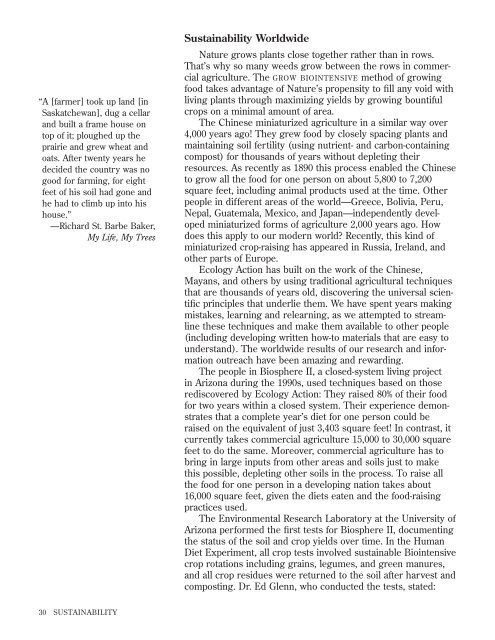How to Grow More Vegetables : And Fruits, Nuts ... - Shroomery
How to Grow More Vegetables : And Fruits, Nuts ... - Shroomery
How to Grow More Vegetables : And Fruits, Nuts ... - Shroomery
You also want an ePaper? Increase the reach of your titles
YUMPU automatically turns print PDFs into web optimized ePapers that Google loves.
“A [farmer] <strong>to</strong>ok up land [in<br />
Saskatchewan], dug a cellar<br />
and built a frame house on<br />
<strong>to</strong>p of it; ploughed up the<br />
prairie and grew wheat and<br />
oats. After twenty years he<br />
decided the country was no<br />
good for farming, for eight<br />
feet of his soil had gone and<br />
he had <strong>to</strong> climb up in<strong>to</strong> his<br />
house.”<br />
—Richard St. Barbe Baker,<br />
My Life, My Trees<br />
30 SUSTAINABILITY<br />
Sustainability Worldwide<br />
Nature grows plants close <strong>to</strong>gether rather than in rows.<br />
That’s why so many weeds grow between the rows in commercial<br />
agriculture. The GROW BIOINTENSIVE method of growing<br />
food takes advantage of Nature’s propensity <strong>to</strong> fill any void with<br />
living plants through maximizing yields by growing bountiful<br />
crops on a minimal amount of area.<br />
The Chinese miniaturized agriculture in a similar way over<br />
4,000 years ago! They grew food by closely spacing plants and<br />
maintaining soil fertility (using nutrient- and carbon-containing<br />
compost) for thousands of years without depleting their<br />
resources. As recently as 1890 this process enabled the Chinese<br />
<strong>to</strong> grow all the food for one person on about 5,800 <strong>to</strong> 7,200<br />
square feet, including animal products used at the time. Other<br />
people in different areas of the world—Greece, Bolivia, Peru,<br />
Nepal, Guatemala, Mexico, and Japan—independently developed<br />
miniaturized forms of agriculture 2,000 years ago. <strong>How</strong><br />
does this apply <strong>to</strong> our modern world? Recently, this kind of<br />
miniaturized crop-raising has appeared in Russia, Ireland, and<br />
other parts of Europe.<br />
Ecology Action has built on the work of the Chinese,<br />
Mayans, and others by using traditional agricultural techniques<br />
that are thousands of years old, discovering the universal scientific<br />
principles that underlie them. We have spent years making<br />
mistakes, learning and relearning, as we attempted <strong>to</strong> streamline<br />
these techniques and make them available <strong>to</strong> other people<br />
(including developing written how-<strong>to</strong> materials that are easy <strong>to</strong><br />
understand). The worldwide results of our research and information<br />
outreach have been amazing and rewarding.<br />
The people in Biosphere II, a closed-system living project<br />
in Arizona during the 1990s, used techniques based on those<br />
rediscovered by Ecology Action: They raised 80% of their food<br />
for two years within a closed system. Their experience demonstrates<br />
that a complete year’s diet for one person could be<br />
raised on the equivalent of just 3,403 square feet! In contrast, it<br />
currently takes commercial agriculture 15,000 <strong>to</strong> 30,000 square<br />
feet <strong>to</strong> do the same. <strong>More</strong>over, commercial agriculture has <strong>to</strong><br />
bring in large inputs from other areas and soils just <strong>to</strong> make<br />
this possible, depleting other soils in the process. To raise all<br />
the food for one person in a developing nation takes about<br />
16,000 square feet, given the diets eaten and the food-raising<br />
practices used.<br />
The Environmental Research Labora<strong>to</strong>ry at the University of<br />
Arizona performed the first tests for Biosphere II, documenting<br />
the status of the soil and crop yields over time. In the Human<br />
Diet Experiment, all crop tests involved sustainable Biointensive<br />
crop rotations including grains, legumes, and green manures,<br />
and all crop residues were returned <strong>to</strong> the soil after harvest and<br />
composting. Dr. Ed Glenn, who conducted the tests, stated:












